Chapter 6F. Temporary Traffic Control Zone Devices
Section 6F.01 Types of Devices
Support:
Whenever the acronym "TTC" is used in this Chapter, it
refers to "temporary traffic control".
Standard:
The needs and control of all road users (motorists, bicyclists,
and pedestrians within the highway, including persons with disabilities
in accordance with the Americans with Disabilities Act of 1990 (ADA),
Title II, Paragragh 35.130) through a TTC zone shall be an essential
part of highway construction, utility work, maintenance operations,
and the management of traffic incidents.
Guidance:
The design and application of TTC devices used in TTC zones should consider the needs of all road users (motorists, bicyclists, and pedestrians), including those with disabilities.
Support:
FHWA policy requires that all roadside appurtenances such as traffic
barriers, barrier terminals and crash cushions, bridge railings,
sign and light pole supports, and work zone hardware used on the
National Highway System meet the crashworthy performance criteria
contained in the National Cooperative Highway Research Program (NCHRP)
Report 350, "Recommended Procedures for the Safety Performance
Evaluation of Highway Features". The FHWA website at http://safety.fhwa.dot.gov/roadway_dept/policy_guide/road_hardware/index.cfm
identifies all such hardware and includes copies of FHWA acceptance
letters for each of them. In the case of proprietary items, links
are provided to manufacturers' websites as a source of detailed
information on specific devices. The website also contains an "Ask
the Experts" section where questions on roadside design issues
can be addressed. State Departments of Transportation and local
agencies might also have expanded the NCHRP Report 350 crashworthy
criteria to apply to other highways in addition to the National
Highway System.
Crashworthiness and crash testing information on devices described in Part 6 are found in AASHTO's "Roadside Design Guide" (see Section 1A.11).
As stated in Definition 17 in Section 1A.13, "crashworthy" is a characteristic of a roadside appurtenance that has been successfully crash tested in accordance with a national standard such as the National Cooperative Highway Research Program Report 350, "Recommended Procedures for the Safety Performance Evaluation of Highway Features".
Standard:
Traffic control devices shall be defined as all signs, signals,
markings, and other devices used to regulate, warn, or guide road
users, placed on, over, or adjacent to a street, highway, pedestrian
facility, or bikeway by authority of a public body or official having
jurisdiction.
All traffic control devices used on street and highway construction, maintenance, utility, or incident management operations shall conform to the applicable provisions of this Manual.
Section 6F.02 General Characteristics of Signs
Support:
TTC zone signs convey both general and specific messages by means
of words or symbols and have the same three categories as all road
user signs: regulatory, warning, and guide.
Standard:
The colors for regulatory signs shall follow the Standards for regulatory
signs in Table 2A-5 and
Chapter 2B. Warning signs in
TTC zones shall have a black legend and border on an orange background,
except for the Highway-Rail Grade Crossing Advance Warning (W10-1)
sign which shall have a black legend and border on a yellow background,
and except for signs that are permitted in Parts 2
or 7 to have
fluorescent yellow-green backgrounds. Colors for guide signs shall
follow the Standards in Table 2A-5 and Chapter
2D, except for guide signs as noted in Section
6F.50.
Option:
Where the color orange is required, fluorescent red-orange or fluorescent
yellow-orange colors may also be used.
Support:
The fluorescent versions of orange provide higher conspicuity than
standard orange, especially during twilight.
Option:
Warning and guide signs used for TTC incident management situations
(see Chapter 6I) may have a black legend
and border on a fluorescent pink background.
Existing warning signs that are still applicable may remain in place.
In order to maintain the systematic use of yellow or fluorescent yellow-green background for pedestrian, bicycle, and school warning signs in a jurisdiction, the yellow or fluorescent yellow-green background for pedestrian, bicycle, and school warning signs may be used in TTC zones.
Standard orange flags or flashing warning lights may be used in conjunction with signs.
Standard:
When standard orange flags or flashing warning lights are used in
conjunction with signs, they shall not block the sign face.
The sizes for TTC signs shall be as shown in Table 6F-1.
Option:
The dimensions of signs shown in Table 6F-1 may be increased wherever
necessary for greater legibility or emphasis, such as on freeways
and expressways.
Notes:
- Larger signs may be used wherever necessary for greater legibility or emphasis.
- Dimensions are shown in millimeters followed by inches in parentheses and are shown as width x height.
- For freeways and expressways, the size of diamond shaped TTC warning signs shall be a minimum of 1200 x 1200 mm (48 x 48 in).
Standard:
Deviations from standard sizes as prescribed herein shall be in
150 mm (6 in) increments.
Support:
Sign design details are contained in the "Standard Highway
Signs" book (see Section 1A.11).
Standard:
All signs used at night shall be either retroreflective with a material
that has a smooth, sealed outer surface or illuminated to show the
same shape and similar color both day and night.
The requirement for sign illumination shall not be considered to be satisfied by street, highway, or strobe lighting.
Option:
Sign illumination may be either internal or external.
Signs may be made of rigid or flexible material.
Section 6F.03 Sign Placement
Guidance:
Signs should be located on the right side of the roadway unless
otherwise specified in this Manual.
Option:
Where special emphasis is needed, signs may be placed on both the
left and right sides of the roadway. Signs mounted on portable supports
may be placed within the roadway itself. Signs may also be mounted
on or above barricades.
Support:
The provisions of this Section regarding mounting height apply unless
specifically stated otherwise for a particular sign elsewhere in
this Manual.
Guidelines for height and lateral clearance of temporary ground-mounted signs are shown in Figure 6F-1.
Figure 6F-1 Height and Lateral Location of Signs—Typical Installations
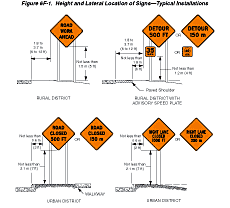
Standard:
Ground-mounted signs installed at the side of the road in rural
areas shall be mounted at a height of at least 1.5 m (5 ft), measured
from the bottom of the sign to the near edge of the pavement. In
business, commercial, and residential districts where parking and/or
bicycle or pedestrian movement is likely to occur, or where there
are other obstructions to view, the distance between the bottom
of the sign and the top of the near edge of the traveled way shall
be at least 2.1 m (7 ft).
Signs mounted on barricades and barricade/sign combinations shall be crashworthy.
Where it has been determined that the accommodation of pedestrians with disabilities is necessary, signs shall be mounted and placed in accordance with Section 4.4 of the "Americans with Disabilities Act Accessibility Guidelines for Buildings and Facilities (ADAAG)" (see Section 1A.11).
Guidance:
Neither portable nor permanent sign supports should be located on
sidewalks, bicycle facilities, or areas designated for pedestrian
or bicycle traffic. Signs mounted lower than 2.1 m (7 ft) should
not project more than 100 mm (4 in) into pedestrian facilities.
Option:
A 2.1 m (7 ft) mounting height may be used in rural areas for increased
visibility.
The height to the bottom of a secondary sign mounted below another sign may be 0.3 m (1 ft) less than the appropriate height specified above.
Guidance:
Except as noted in the Option, signs mounted on portable supports
should not be used for a duration of more than 3 days.
Option:
The R9-8 through R9-11a series, R11 series, W1-6 through W1-8 series,
M4-10, E5-1, or other similar type signs (see Figures 6F-3,
6F-4, and 6F-5)
may be used on portable supports for longer than 3 days.
Support:
Methods of mounting signs other than on posts are illustrated in
Figure 6F-2.
Figure 6F-2 Methods of Mounting Signs Other Than on Posts
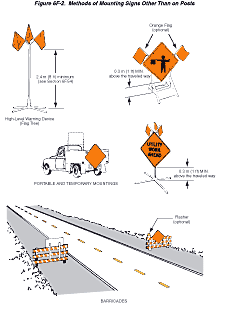
Guidance:
Signs mounted on Type III barricades should not cover more than
50 percent of the top two rails or 33 percent of the total area
of the three rails.
Standard:
Sign supports shall be crashworthy. Large signs having an area exceeding
5 square meters (50 square feet) that are installed on multiple
breakaway posts shall be mounted a minimum of 2.1 m (7 ft) above
the ground.
Signs mounted on barricades, or other portable supports, shall be no less than 0.3 m (1 ft) above the traveled way.
Option:
For mobile operations, a sign may be mounted on a work vehicle,
a shadow vehicle, or a trailer stationed in advance of the TTC zone
or moving along with it. The work vehicle, the shadow vehicle, or
the trailer may or may not have an impact attenuator.
Guidance:
Unshielded sign posts placed in the clear zone should yield or breakaway
upon impact to minimize obstructions to road users.
Support:
If alterations are made to specific traffic control device supports
that have been successfully crash tested in accordance with NCHRP
Report 350 (see Section
1A.11), the altered supports might not be considered to be crashworthy.
Section 6F.04 Sign Maintenance
Standard:
Signs shall be properly maintained for cleanliness, visibility,
and correct positioning.
Signs that have lost significant legibility shall be promptly replaced.
Section 6F.05 Regulatory Sign Authority
Support:
Regulatory signs such as those shown in Figure 6F-3 inform road
users of traffic laws or regulations and indicate the applicability
of legal requirements that would not otherwise be apparent.
Standard:
Regulatory signs shall be authorized by the public agency or official
having jurisdiction and shall conform with Chapter 2B.
Figure 6F-3 Regulatory Signs in Temporary Traffic Control Zones (2 Sheets)
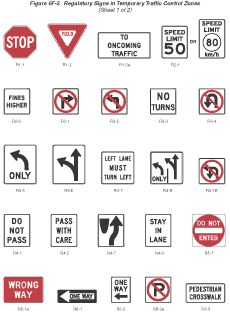
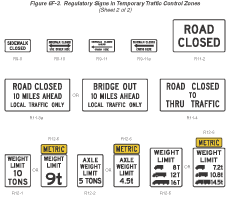
Section 6F.06 Regulatory Sign Design
Standard:
TTC regulatory signs shall conform to the Standards for regulatory
signs presented in Part 2 and in the FHWA's "Standard Highway
Signs" book (see Section 1A.11).
Support:
Regulatory signs are generally rectangular with a black legend and
border on a white background. Exceptions include the STOP, YIELD,
DO NOT ENTER, WRONG WAY, and ONE WAY signs.
Option:
The ONE WAY sign may be either a horizontal or vertical rectangular
sign.
Section 6F.07 Regulatory Sign Applications
Standard:
If a TTC zone requires regulatory measures different from those
existing, the existing permanent regulatory devices shall be removed
or covered and superseded by the appropriate temporary regulatory
signs. This change shall be made in conformance with applicable
ordinances or statutes of the jurisdiction.
Section 6F.08 ROAD (STREET) CLOSED Sign (R11-2)
Guidance:
The ROAD (STREET) CLOSED (R11-2) sign (see Figure
6F-3, Sheet 2 of 2) should be used when the roadway is closed
to all road users except contractors' equipment or officially authorized
vehicles. The R11-2 sign should be accompanied by appropriate warning
and detour signing.
Option:
The words BRIDGE OUT (or BRIDGE CLOSED) may be substituted for ROAD
(STREET) CLOSED where applicable.
Guidance:
The ROAD (STREET) CLOSED sign should be installed at or near the
center of the roadway on or above a Type III barricade that closes
the roadway (see Section 6F.63).
Standard:
The ROAD (STREET) CLOSED sign shall not be used where road user
flow is maintained or where the actual closure is some distance
beyond the sign.
Section 6F.09 Local Traffic Only Signs (R11-3a, R11-4)
Guidance:
The Local Traffic Only signs (see Figure
6F-3, Sheet 2 of 2) should be used where road user flow detours
to avoid a closure some distance beyond the sign, but where local
road users can use the roadway to the point of closure. These signs
should be accompanied by appropriate warning and detour signing.
In rural applications, the Local Traffic Only sign should have the legend ROAD CLOSED XX km (MILES) AHEAD, LOCAL TRAFFIC ONLY (R11-3a).
Option:
In urban areas, the legend ROAD (STREET) CLOSED TO THRU TRAFFIC
(R11-4) or ROAD CLOSED, LOCAL TRAFFIC ONLY may be used.
The words BRIDGE OUT (or BRIDGE CLOSED) may be substituted for the words ROAD (STREET) CLOSED on the R11-3a or R11-4 sign where applicable.
Section 6F.10 Weight Limit Signs (R12-1, R12-2, R12-5)
Standard:
A Weight Limit sign (see Figure 6F-3, Sheet 2 of 2), which shows
the gross weight or axle weight that is permitted on the roadway
or bridge, shall be consistent with State or local regulations and
shall not be installed without the approval of the authority having
jurisdiction over the highway.
When weight restrictions are imposed because of the activity in a TTC zone, a marked detour shall be provided for vehicles weighing more than the posted limit.
Section 6F.11 STAY IN LANE Sign (R4-9)
Option:
A STAY IN LANE (R4-9) sign (see Figure
6F-3, Sheet 1 of 2) may be used where a multi-lane shift has
been incorporated as part of the TTC on a highway to direct road
users around road work that occupies part of the roadway on a multi-lane
highway.
Section 6F.12 PEDESTRIAN CROSSWALK Sign (R9-8)
Option:
The PEDESTRIAN CROSSWALK (R9-8) sign (see Figure 6F-3, Sheet 1 of
2) may be used to indicate where a temporary crosswalk has been
established.
Standard:
If a temporary crosswalk is established, it shall be accessible
to pedestrians with disabilities inaccordance with Section
6D.02.
Section 6F.13 SIDEWALK CLOSED Signs (R9-9, R9-10, R9-11, R9-11a)
Guidance:
SIDEWALK CLOSED signs (see Figure
6F-3, Sheet 2 of 2) should be used where pedestrian flow is
restricted. Bicycle/Pedestrian Detour (M4-9a) signs or Pedestrian
Detour (M4-9b) signs should be used where pedestrian flow is rerouted
(see Section 6F.53).
The SIDEWALK CLOSED (R9-9) sign should be installed at the beginning of the closed sidewalk, at the intersections preceding the closed sidewalk, and elsewhere along the closed sidewalk as needed.
The SIDEWALK CLOSED, (ARROW) USE OTHER SIDE (R9-10) sign should be installed at the beginning of the restricted sidewalk when a parallel sidewalk exists on the other side of the roadway.
The SIDEWALK CLOSED AHEAD, (ARROW) CROSS HERE (R9-11) sign should be used to indicate to pedestrians that sidewalks beyond the sign are closed and to direct them to open crosswalks, sidewalks, or other travel paths.
The SIDEWALK CLOSED, (ARROW) CROSS HERE (R9-11a) sign should be installed just beyond the point to which pedestrians are being redirected.
Support:
These signs are typically mounted on a detectable barricade to encourage
compliance and to communicate with pedestrians that the sidewalk
is closed. Printed signs are not useful to many pedestrians with
visual disabilities. A barrier or barricade detectable by a person
with a visual disability is sufficient to indicate that a sidewalk
is closed. If the barrier is continuous with detectable channelizing
devices for an alternate route, accessible signage might not be
necessary. An audible information device is needed when the detectable
barricade or barrier for an alternate channelized route is not continuous.
Section 6F.14 Special Regulatory Signs
Option:
Special regulatory signs may be used based on engineering judgment
consistent with regulatory requirements.
Guidance:
Special regulatory signs should conform to the general requirements
of color, shape, and alphabet size and series. The sign message
should be brief, legible, and clear.
Support:
Section 2B.17 contains
information regarding the use of FINES HIGHER signs (see Figure
6F-3, Sheet 1 of 2).
Section 6F.15 Warning Sign Function, Design, and Application
Support:
TTC zone warning signs (see Figure 6F-4) notify road users of specific
situations or conditions on or adjacent to a roadway that might
not otherwise be apparent.
Figure 6F-4 Warning Signs in Temporary Traffic Control Zones (4 Sheets)
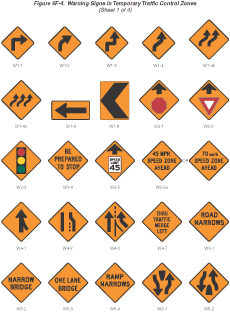
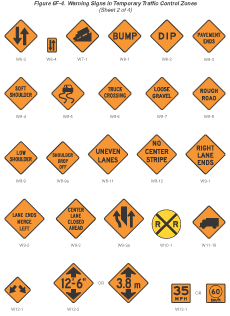
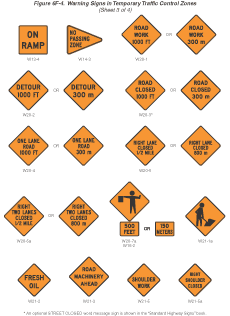
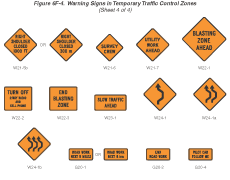

Figure 6F-5 Exit Open and Closed and Detour Signs

Standard:
TTC warning signs shall conform to the Standards for warning signs
presented in Part 2 and in FHWA's "Standard Highway Signs"
book (see Section 1A.11). Except as noted in the Option below, TTC
warning signs shall be diamond-shaped with a black legend and border
on an orange background, except for the W10-1 sign which shall have
a black legend and border on a yellow background, and except for
signs that are permitted in Parts 2 or 7 to have fluorescent yellow-green
backgrounds.
Option:
Warning signs used for TTC incident management situations may have
a black legend and border on a fluorescent pink background.
Mounting or space considerations may justify a change from the standard diamond shape.
In emergencies, available warning signs having yellow backgrounds may be used if signs with orange or fluorescent pink backgrounds are not at hand.
Guidance:
Where roadway or road user conditions require greater emphasis,
larger than standard size warning signs should be used, with the
symbol or legend enlarged approximately in proportion to the outside
dimensions.
Where any part of the roadway is obstructed or closed by work activities or incidents, advance warning signs should be installed to alert road users well in advance of these obstructions or restrictions.
Where road users include pedestrians, the provision of supplemental audible information or detectable barriers or barricades should be considered for people with visual disabilities.
Support:
Detectable barriers or barricades communicate very clearly to pedestrians
who have visual disabilities that they can no longer proceed in
the direction that they are traveling.
Option:
Advance warning signs may be used singly or in combination.
Standard:
Because of their importance, advance warning signs for higher-speed
locations shall have a size of 1200 x 1200 mm (48 x 48 in) (see
Part 2).
For freeways and expressways, the size of diamond shaped TTC warning signs shall be a minimum of 1200 x 1200 mm (48 x 48 in).
Option:
Where speeds and volumes are moderately low, a minimum size of 900
x 900 mm (36 x 36 in) may be used for advance warning signs.
On secondary roads or City streets where speeds are very low, signs smaller than the standard size, but not less than 600 x 600 mm (24 x 24 in), may be used for warning signs having short word messages or clear symbols.
Advance warning signs larger than the minimum standards may be used for additional emphasis of the TTC zone (see Part 2).
Where distances are not shown on warning signs as part of the message, a supplemental plaque with the distance legend may be mounted immediately below the sign on the same support.
Section 6F.16 Position of Advance Warning Signs
Guidance:
Where highway conditions permit, warning signs should be placed
in advance of the TTC zone at varying distances depending on roadway
type, condition, and posted speed. Table
6C-1 contains information regarding the spacing of advance warning
signs. Where a series of two or more advance warning signs is used,
the closest sign to the TTC zone should be placed approximately
30 m (100 ft) for low-speed urban streets to 300 m (1,000 ft) or
more for freeways and expressways.
Support:
Various conditions, such as limited sight distance or obstructions
that might require a driver to reduce speed or stop, might require
additional advance warning signs.
Option:
As an alternative to a specific distance on advance warning signs,
the word AHEAD may be used.
Support:
At TTC zones on lightly-traveled roads, all of the advance warning
signs prescribed for major construction might not be needed.
Option:
Utility work, maintenance, or minor construction can occur within
the TTC zone limits of a major construction project, and additional
warning signs may be needed.
Guidance:
Utility, maintenance, and minor construction signing and TTC should
be coordinated with appropriate authorities so that road users are
not confused or misled by the additional TTC devices.
